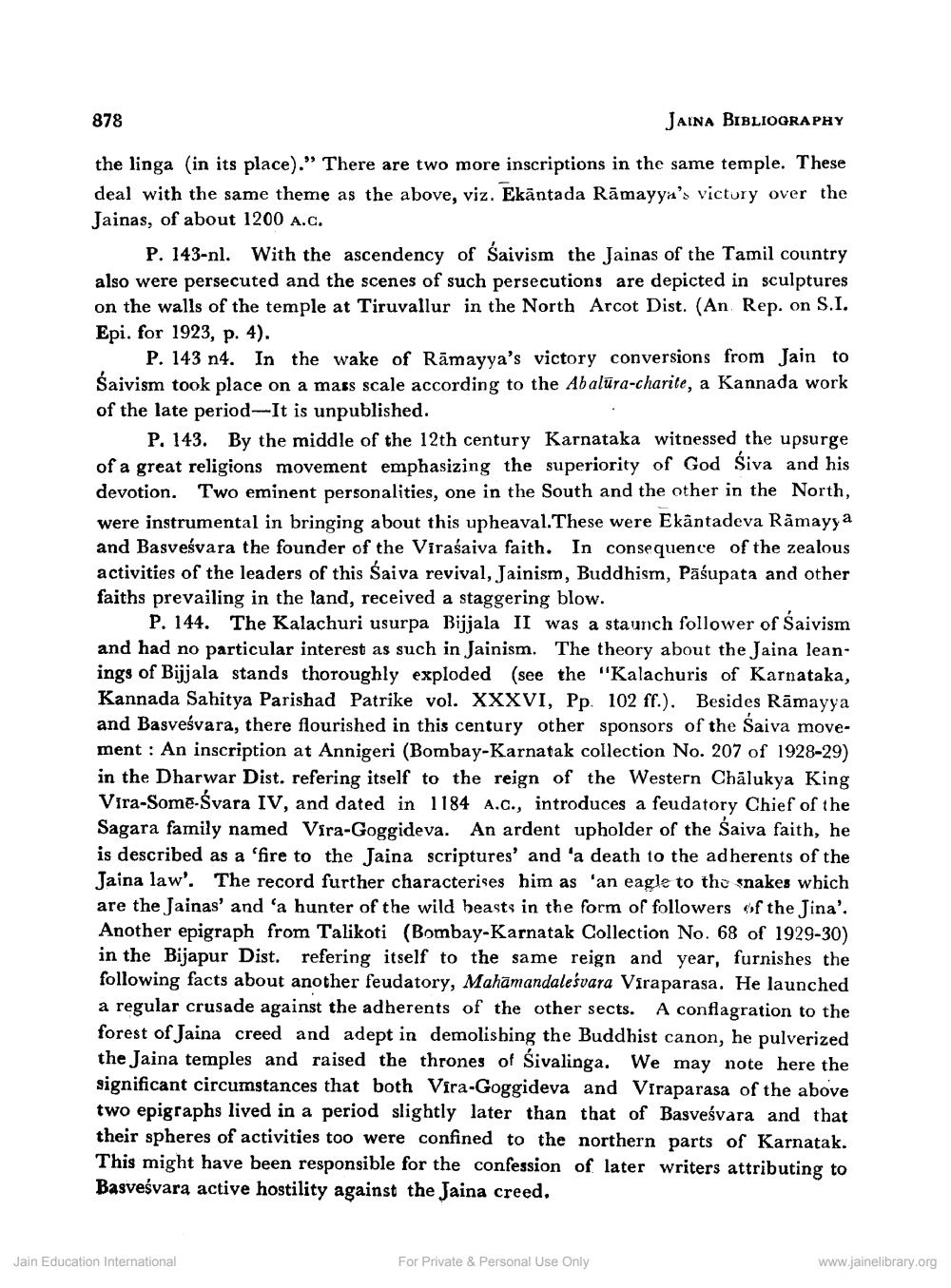________________
878
JAINA BIBLIOGRAPHY
the linga (in its place)." There are two more inscriptions in the same temple. These deal with the same theme as the above, viz. Ekantada Ramayya's victory over the Jainas, of about 1200 A.C.
P. 143-nl. With the ascendency of Saivism the Jainas of the Tamil country also were persecuted and the scenes of such persecutions are depicted in sculptures on the walls of the temple at Tiruvallur in the North Arcot Dist. (An Rep. on S.I. Epi. for 1923, p. 4).
P. 143 n4. In the wake of Ramayya's victory conversions from Jain to Śaivism took place on a mass scale according to the Abalura-charite, a Kannada work of the late period-It is unpublished.
P. 143. By the middle of the 12th century Karnataka witnessed the upsurge of a great religions movement emphasizing the superiority of God Śiva and his devotion. Two eminent personalities, one in the South and the other in the North, were instrumental in bringing about this upheaval.These were Ekântadeva Ramayya and Basvesvara the founder of the Viraśaiva faith. In consequence of the zealous activities of the leaders of this Saiva revival, Jainism, Buddhism, Pasupata and other faiths prevailing in the land, received a staggering blow.
P. 144. The Kalachuri usurpa Bijjala II was a staunch follower of Saivism and had no particular interest as such in Jainism. The theory about the Jaina leanings of Bijjala stands thoroughly exploded (see the "Kalachuris of Karnataka, Kannada Sahitya Parishad Patrike vol. XXXVI, Pp. 102 ff.). Besides Ramayya and Basvesvara, there flourished in this century other sponsors of the Saiva movement: An inscription at Annigeri (Bombay-Karnatak collection No. 207 of 1928-29) in the Dharwar Dist. refering itself to the reign of the Western Chalukya King Vira-Some-Svara IV, and dated in 1184 A.c., introduces a feudatory Chief of the Sagara family named Vira-Goggideva. An ardent upholder of the Saiva faith, he is described as a 'fire to the Jaina scriptures' and 'a death to the adherents of the Jaina law'. The record further characterises him as 'an eagle to the snakes which are the Jainas' and 'a hunter of the wild beasts in the form of followers of the Jina'. Another epigraph from Talikoti (Bombay-Karnatak Collection No. 68 of 1929-30) in the Bijapur Dist. refering itself to the same reign and year, furnishes the following facts about another feudatory, Mahamandaleivara Viraparasa. He launched a regular crusade against the adherents of the other sects. A conflagration to the forest of Jaina creed and adept in demolishing the Buddhist canon, he pulverized the Jaina temples and raised the thrones of Sivalinga. We may note here the significant circumstances that both Vira-Goggideva and Viraparasa of the above two epigraphs lived in a period slightly later than that of Basvelvara and that their spheres of activities too were confined to the northern parts of Karnatak. This might have been responsible for the confession of later writers attributing to Basvelvara active hostility against the Jaina creed.
Jain Education International
For Private & Personal Use Only
www.jainelibrary.org




